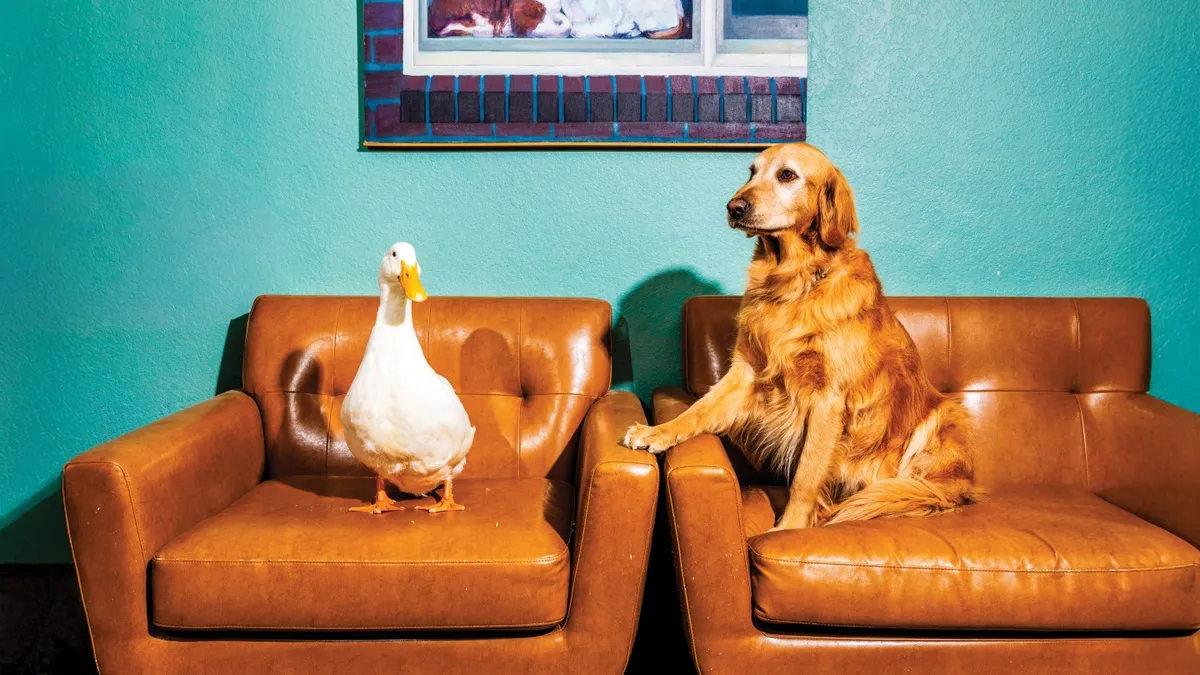
Rocco, a talented canine actor, may not have landed a film or television role in several years, but he remains active and engaged. Living about an hour north of Los Angeles in a picturesque valley, Rocco keeps his days filled with various activities. On a breezy July afternoon, he enjoys playful moments with his long-time companion, Porter, a golden retriever. Their tranquility is soon interrupted by the introduction of a green plush alligator toy, leading to a lively game of tug-of-war. This playful chaos is a reminder of the joys of being a dog actor, but Rocco's story reflects a broader trend in the industry.
Despite Rocco's impressive credits, including roles in Veronica Mars, Jane the Virgin, and The Morning Show, many animal actors in the Los Angeles area are struggling to find work. The rise of artificial intelligence in filmmaking has led to a significant shift, with productions increasingly opting to create animal performances digitally rather than filming with live animals. This trend has left trainers, wranglers, and animal coordinators anxious about their future in the industry.
Karin McElhatton, owner of Studio Animal Services, which houses Rocco and many other animals, highlights the profound impact of AI on the business. Her facility supplies animal talent for major productions like Ghostbusters, L.A. Confidential, and CSI: Miami. “It has certainly impacted the studio animal trainers and the studio animal business already quite a lot,” McElhatton explains, underscoring the challenges posed not only by AI but also by the fallout from COVID-19 and recent strikes in the entertainment industry.
Benay Karp, the owner of Benay’s Bird & Animal Rentals, has also observed a decline in job opportunities for her animals, estimating that current work levels are only about 40 percent of what they were before the pandemic. Karp specializes in small wildlife and birds but primarily works with dogs and cats. She notes, “I don’t think I’ve had a call for a woodpecker in probably three or four years, maybe five years.” This downturn reflects a broader trend in the industry, where even the most beloved animal actors are becoming less frequent on screen.
While wild animals such as lions, bears, and wolves have historically worked less frequently due to safety concerns and pressure from animal welfare organizations, the decline now extends to domesticated animals. Iconic canine stars like Lassie and Rin Tin Tin are becoming relics of the past. Recent films like Call of the Wild featured computer-generated animals, while even the sidekick pup Krypto in this year’s Superman was a digital rendition of director James Gunn’s dog.
Concerns are even surfacing regarding the future of equine performers. While some filmmakers still prefer real horses, trainers like Lisa Brown note that the industry may eventually shift towards digital solutions for cost efficiency. “In Secretariat, we had five horses that made up the same horse, and I would literally hand-paint them to match one another,” Brown shares. “Now, I don’t know why in the future they just couldn’t digitally do it more cost-effectively.”
Not everyone is lamenting this shift toward AI in filmmaking. The People for the Ethical Treatment of Animals (PETA) has long advocated for the removal of real animals from film sets, arguing that their use for entertainment purposes is inherently cruel. Lauren Thomasson, director of PETA’s film and TV division, sees technology as a means to improve animal welfare. “This is one way AI can be used for a really good thing, which is ending the suffering of animals in the entertainment industry,” she states.
However, many animal experts within the industry argue that the essence of real animal performances cannot be replicated. Bonnie Judd, an animal coordinator based in British Columbia, believes that the emotional authenticity of live animals brings a depth to performances that AI cannot replicate. She recalls a powerful scene in A Dog’s Journey that elicited genuine tears from the studio audience, demonstrating the unique connection between animals and their human counterparts.
As Rocco and Porter are coaxed away from their toys at Studio Animal Services, they are drawn to a picturesque spot for a photo opportunity, showcasing their enduring charm. While the landscape of animal acting in Hollywood continues to evolve, the heartwarming bond between animals and their trainers remains a vital aspect of the entertainment industry. Rocco may not be landing roles as frequently as he once did, but he still embodies the joy and spirit that makes animal performances so beloved by audiences everywhere.